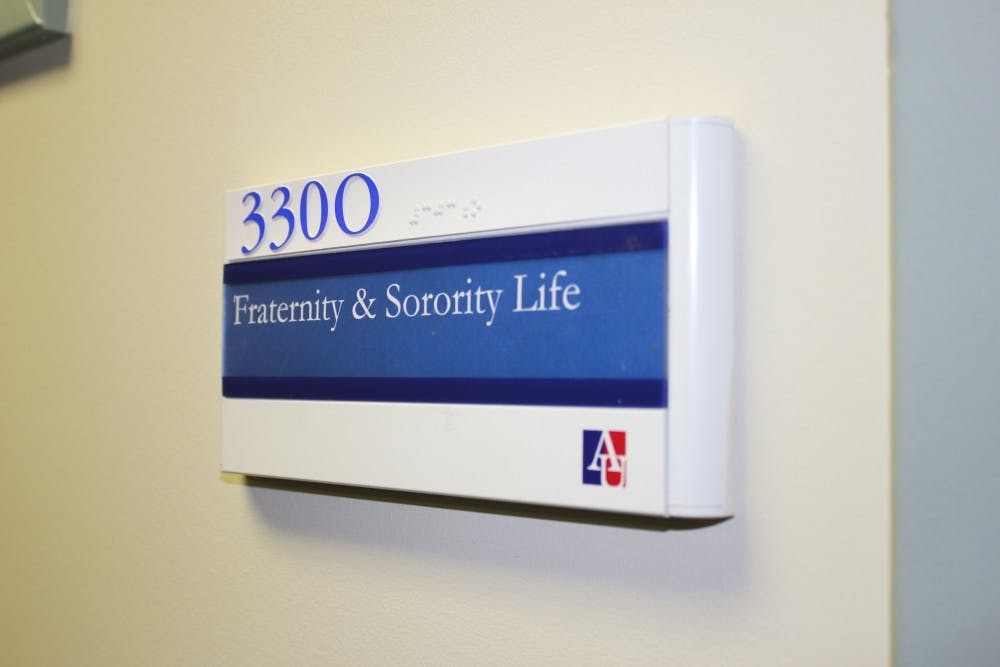Fraternities at American University have responded to photos of previous members in blackface and other photos “of concern” published by The Eagle earlier this month.
The Eagle staff identified several photos after Provost Daniel Myers and Vice President of Campus Life and Inclusive Excellence Fanta Aw sent out a Feb. 12 email memo to the AU community stating that 15 images “of concern” were found in previous AU yearbooks.
The Eagle reviewed online archives of the yearbooks ranging from 1926 to 1998. The analysis revealed at least four images depicting students in blackface, including pictures of fraternity members performing in a minstrel show. The photos range in date from the mid-1950s to the early 1960s, with the last blackface photo appearing in 1963.
Members of Phi Sigma Kappa contacted The Eagle and asked that two photos, one showing a brother in a Native American headdress and the other depicting a hanging effigy, be removed on the grounds that they could not be proven to be racist.
Armand Yannone, a brother in PSK, sent an email to The Eagle claiming that the hanging depicted a medieval execution and the brother wearing the headdress was “part Cherokee.” The photos were eventually removed after the paper determined they could not be immediately verified. Members of PSK were not available for additional comment on this story after multiple requests.
Additionally, Edward Gaylord, the president of AU’s chapter of Alpha Sigma Phi, contacted The Eagle and asked that a photograph of their members in blackface be removed from the article “as the photos removed for PSK were no less controversial than [their] own.”
Gaylord stated that he and his fraternity was prepared to file a defamation suit against The Eagle if the photo was not removed (Gaylord said the fraternity no longer plans to do so). In a statement, Gaylord acknowledged that the photo featured “members of our chapter from the 1950s wearing what appears to be blackface.”
“We condemn all uses of blackface; a despicable practice which has no place at our university and in our organization,” Gaylord said. “We reaffirm our commitment to ensuring all cultures and identities are respected in the realm of our traditions and activities as a fraternity.”
Gaylord added that bigotry and intolerance have no place in their chapter and the fraternity does not discriminate against age, ethnicity, religious affiliation, sexual orientation or nationality.
The University will not confirm which yearbook photos are the images “of concern” they identified, according to AU spokesperson Kelly Alexander. Alexander said via email that the University is planning an “educational event” to examine the identified photos further.
“Library faculty and staff will be joined by additional scholars (with expertise in areas that relate to this work such as history) to confirm the context of the photos and help shape the educational event,” Alexander wrote.
The photos will be released by the University at some point following the event, Alexander told The Eagle.
The uncovering of blackface in university yearbooks garnered national attention after a photo of Virginia Governor Ralph Northam wearing either a Ku Klux Klan hood or blackface was discovered in his medical school yearbook.
However, the issue of racism in fraternities is not a new issue, says Matthew Hughey, a sociology professor at the University of Connecticut known for his work on race and racism within fraternities.
“In the founding of a lot of these organizations in the 1800s and 1900s, official racial, religious and exclusionary language [was included] in their constitution,” Hughey said. “Many of these organizations didn't get rid of that language until the 1960s and 70s when they started being sued, but their practices did not change a whole lot.”
Hughey added that research shows about 95 percent of the membership of historically white Greek organizations are composed of members who identify as white and that segregation still exists within those fraternities.
“They are some of the most segregated spaces in America today,” Hughey said. “They behave as a networking and social vehicle because they're based on exclusion. So, whoever gets in then gets access to resources, and that access helps to reproduce white dominance on campus.”
Data about the demographic makeup of fraternities at AU is not publicly available, and Benjamin Khoshbin, the president of AU’s Interfraternity Council, said the IFC does not collect or have access to that type of data.
Khoshbin said the photos of students in blackface do not represent fraternities at the University now.
“While I am disheartened and disturbed by these photos from the 1950’s/60’s, I do not believe that they are reflective of our IFC community today,” Khoshbin wrote. “Our community is vibrant and diverse - we accept and are comprised of all races, ethnicities, sexual orientations, backgrounds, and experiences.”





